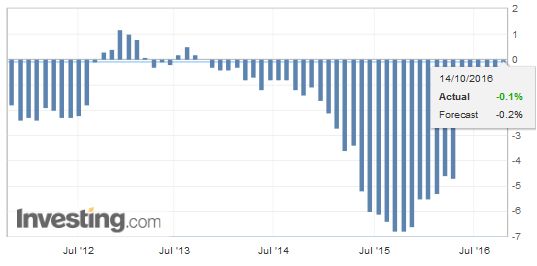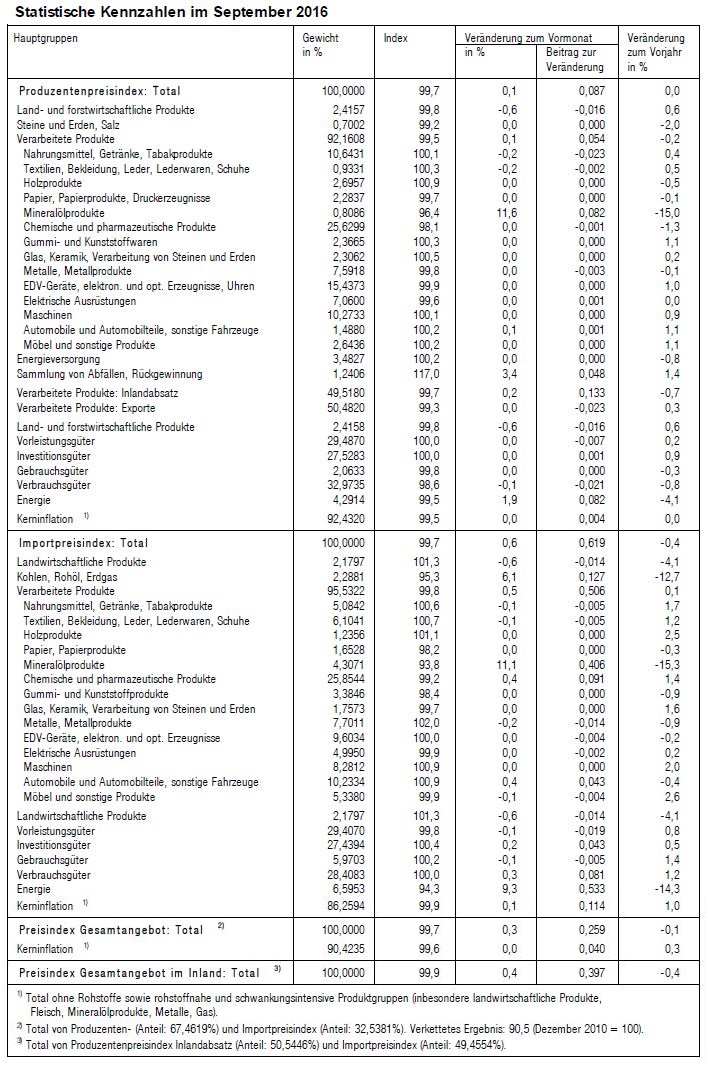Comments by George Dorgan My articles About meMy booksFollow on:TwitterFacebookGoogle +YoutubeSeeking AlphaCFA SocietyLinkedINEconomicBlogs The Producer Price Index (PPI) or officially named "Producer and Import Price Index" describes the changes in prices for producers and importers. For us it is interesting because it is used in the formula for the Real Effective Exchange Rate. When producers and importers profit on lower price changes when compared to other countries, then the Swiss Franc reduces its overvaluation. The Swiss PPI values of -6% in 2015 (see below), compared to -3% in Europe or -1% in the U.S., diminished the overvaluation. See more in Is the Swiss Franc overvalued?. Producer and Import Price Index in September 2016: 0.3% rise in Producer and Import Price Index Neuchâtel, 14.10.2016 (FSO) – The Producer and Import Price Index rose in September 2016 by 0.3% compared with the previous month, reaching 99.7 points (base December 2015 = 100). The rise is due in particular to higher prices for petroleum products. Compared with September 2015, the price level of the whole range of domestic and imported products fell by 0.1%. These are the findings of the Federal Statistical Office (FSO).
Topics:
Swiss Statistics considers the following as important: Featured, newsletter, Swiss Macro, Swiss PPI, Switzerland Producer Price Index
This could be interesting, too:
Nachrichten Ticker - www.finanzen.ch writes Die Performance der Kryptowährungen in KW 9: Das hat sich bei Bitcoin, Ether & Co. getan
Nachrichten Ticker - www.finanzen.ch writes Wer verbirgt sich hinter der Ethereum-Technologie?
Martin Hartmann writes Eine Analyse nach den Lehren von Milton Friedman
Marc Chandler writes March 2025 Monthly
The Producer Price Index (PPI) or officially named "Producer and Import Price Index" describes the changes in prices for producers and importers. For us it is interesting because it is used in the formula for the Real Effective Exchange Rate. When producers and importers profit on lower price changes when compared to other countries, then the Swiss Franc reduces its overvaluation. The Swiss PPI values of -6% in 2015 (see below), compared to -3% in Europe or -1% in the U.S., diminished the overvaluation. See more in Is the Swiss Franc overvalued?.
Producer and Import Price Index in September 2016:
0.3% rise in Producer and Import Price Index
Neuchâtel, 14.10.2016 (FSO) – The Producer and Import Price Index rose in September 2016 by 0.3% compared with the previous month, reaching 99.7 points (base December 2015 = 100). The rise is due in particular to higher prices for petroleum products. Compared with September 2015, the price level of the whole range of domestic and imported products fell by 0.1%. These are the findings of the Federal Statistical Office (FSO).
Swiss Producer and import pricesThe strongly negative change in producer prices in 2015 reduced the Swiss franc overvaluation in terms of the Real Effective Exchange. Now, however, producer prices are approaching the zero change again. It must also be noted that producer prices had fallen by 6% in 2015, while consumer prices went down only by 1.5%. Large margins are hence remaining for the Swiss retail sector. The producer and import price index measures the prices in Switzerland for goods sold by industrial producers to the retail sector and the prices companies paid for imports. |
Switzerland Producer Price Index (PPI) YoY(see more posts on Swiss PPI, Switzerland Producer Price Index, ) Source: Investing.com - Click to enlarge |
Download press release:
Producer and Import Price Index in September 2016
German text:
Produzenten- und Importpreisindex im September 2016
Produzenten- und Importpreisindex steigt um 0,3 Prozent
Neuchâtel, 14.10.2016 (BFS) – Der Gesamtindex der Produzenten- und Importpreise stieg im September 2016 gegenüber dem Vormonat um 0,3 Prozent und erreichte den Stand von 99,7 Punkten (Basis Dezember 2015 = 100). Der Anstieg ist vor allem auf höhere Preise für Mineralölprodukte zurückzuführen. Im Vergleich zum September 2015 ging das Preisniveau des Gesamtangebots von Inland- und Importprodukten um 0,1 Prozent zurück. Dies geht aus den Zahlen des Bundesamts für Statistik (BFS) hervor.
Für den Anstieg des Produzentenpreisindexes gegenüber dem Vormonat waren insbesondere die höheren Preise für Mineralölprodukte und Schrott verantwortlich. Teurer wurde auch Rohmilch. Sinkende Preise beobachtete man hingegen bei Schlachtschweinen und Schweinefleisch.
Höhere Preise gegenüber dem August 2016 registrierte man im Importpreisindex vor allem für Treibstoff, Heizöl sowie Erdöl und Erdgas. Dasselbe gilt für pharmazeutische Spezialitäten, Personenwagen und Bekleidung. Preisrückgänge zeigten dagegen Leder, Lederwaren und Schuhe sowie Kupfer und daraus hergestellte Produkte.


